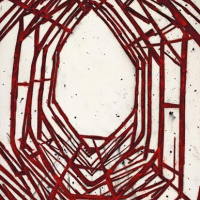40. TONY BEVAN

A noted English painter, Tony Bevan has enjoyed some success with his work in Australia, where he has exhibited with Liverpool Street Gallery in Sydney and Niagara Galleries in Melbourne. Since the 1960s he has exhibited extensively in Europe and the United States, as well as the UK where he is well established and where his work has come to the attention of major public as well as private collections.
Like many English artists Bevans work is highly individual. The British Isles have for some time produced artists whose work, in comparison to mainstream trends from outside the country, run parallel to these trends while confirming their independence. Bevan, like his fellow artists Lucian Freud (1922-1911), Francis Bacon (1909-1992), David Hockney (born 1937), Frank Auerbach (born 1931) and Malcom Morley (1931-2018) tend to eschew categorisation, preferring to forge their own path and thereby needing to be assessed on the merits of their work rather than enjoying the benefits of being positioned within a school of painting or a group. Although few artists are able to entirely shrug off their early influences, English artists often do, and then go on to exist in art-historical isolation as well, because their work similarly refuses to be the starting point for another later generation.
Seen in this light, Tony Bevans work also conforms to the ideas expressed by the contemporary German philosopher Jrgen Habermass, who noted in his examination of Modernist art that artists of the avant-garde were obliged to find direction in a landscape into which no-one seems to have yet ventured.1 Avant-garde artists should forgo any maps when they set out on their voyage of discovery. Bevans work indicates an almost literal acceptance of these ideas, as his paintings of interiors, have something of the character of labyrinths, or contour drawings of landscape. Rooms, passages, corridors, chambers, the sense of a geometric line enclosing animate space, with all of the associations and with implications to the people who have been in them and the events that have taken place in them.
Bevan explores the appearance of things as they relate to, or more intriguingly how they do not relate to, their purpose. His paintings of trees, like his portraits or head studies have the appearance of a plan or schematic rendering of the workings of the sitters mind. In this respect his work does strike a familiar chord, inviting comparison with Lucian Freuds intense character examinations.
A degree of minimalist aesthetic is also evident. Bevans style of working and his intensely personalised subjects are however at odds with the prevailing pure, spare or alternatively sometimes anaemic and vacant minimalism of many of his contemporaries. He uses a unique mixture of pigment and organic coarse textured charcoal and pigment substance on raw canvas that conveys something of the character of rust. Light iridescence and rich colour create a unique effect that adds a further dimension - of time - like the encrustations of the ages, to convey a sense that the work was produced in another era. In this respect his work recalls the German painter Anselm Kiefer (born 1945), whose imagery draws historical and cultural, sometimes uncomfortable, references from European myth and history in order to illuminate more recent history.
Footnotes
1. Hubbard, S., Tony Bevan, New Paintings, Ben Brown Fine Arts, London, online http://www.suehubbard.com
Timothy Abdallah